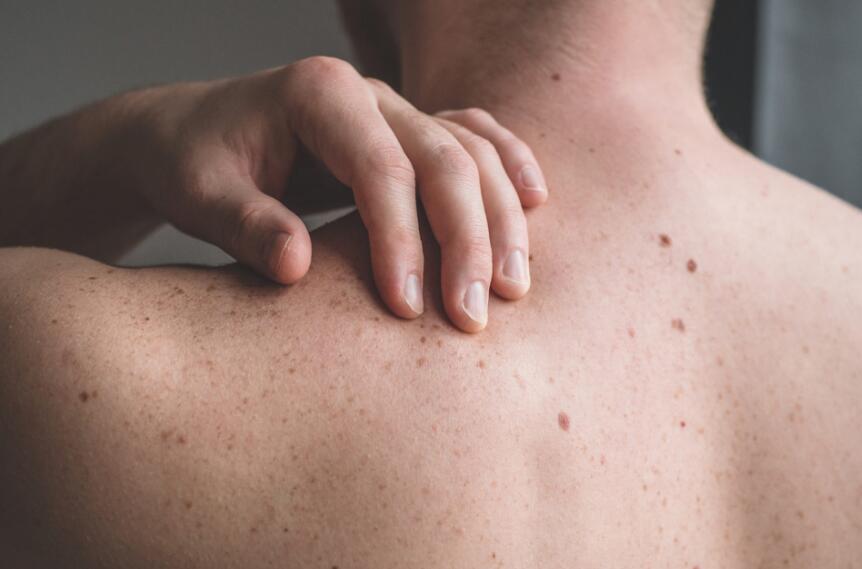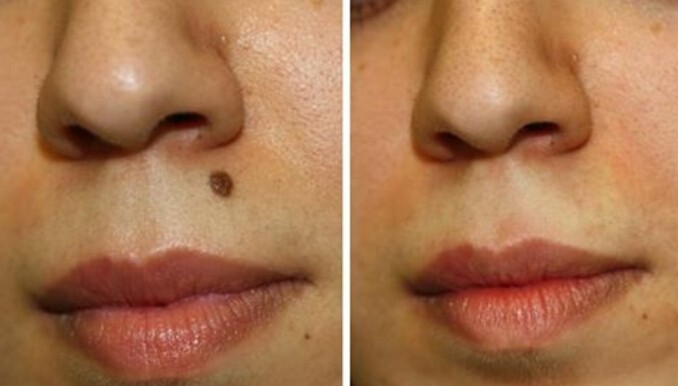Are you tired of dealing with unsightly moles on your skin? If so, you may be interested in learning how to remove them using a natural and cost-effective remedy – apple cider vinegar. In this guide, we will explore the step-by-step process of using apple cider vinegar to remove moles effectively. Whether you have a small mole or a larger one, this method has been proven to provide noticeable results.
What Are Moles?
Moles, medically known as nevi, occur when cells that produce pigment (melanocytes) grow in clusters within the top layer of skin (epidermis). Most people have between 10 to 40 moles by adulthood that may be flesh-toned, brown, black, or reddish in color.
While moles are very common, especially in sun-exposed areas, they develop from gene mutations within skin cells. Specific gene mutations can lead cells to multiply rapidly and form clusters. The vast majority of moles are noncancerous growths that do not turn into melanoma skin cancer.
However, moles can sometimes cause concern if they exhibit warning signs of melanoma, such as:
- Asymmetry: The two halves look different
- Irregular borders
- Changes in size
- Evolving colors
- Diameter larger than 6mm
For this reason, it’s important to monitor existing moles and point out any changes to your doctor. Not all bothersome moles need to be removed though. Many people simply want mole removal for cosmetic reasons if they dislike the location or appearance.

Overview of Apple Cider Vinegar
Apple cider vinegar is created through the fermentation of apple cider, which converts the natural sugars into acetic acid. This compound gives ACV its sour taste and is believed to be responsible for its purported health benefits.
While more evidence is still needed, some research suggests ACV may offer certain benefits like:
- Improving insulin sensitivity and blood sugar control
- Lowering cholesterol
- Increasing satiety and aiding weight loss
- Killing microbes and treating acne when applied to the skin
However, using ACV can also come with risks if not diluted properly or applied appropriately for the situation.
Apple Cider Vinegar for Mole Removal
Now that we’ve covered some basics about moles, let’s discuss how apple cider vinegar ties into mole removal.
Below we’ll explore the main mechanisms behind how ACV could potentially remove moles.
1. Acidity
The acetic acid in ACV gives it a low pH between 2-3, making it highly acidic. This acidity is believed to gradually burn through skin tissue, including that which makes up a mole.
However, keep in mind that healthy skin also has an acidic “mantle” with a pH around 5. This acid mantle serves as a protective barrier against bacteria, viruses, and other pathogens. Removing this protective acidity completely can increase infection risk. There is a delicate balance.
So while ACV can indeed burn skin over time, there are risks to completely eroding skin’s natural acidity. Mole removal requires only damaging the mole itself, not all surrounding tissue.
2. Antimicrobial Effects
In addition to acetic acid, ACV also contains specific compounds like malic acid, acetic acid, and gallic acid that demonstrate antimicrobial properties in lab research.
For example, ACV has shown antibacterial and antifungal effects against E. coli, Staphylococcus aureus, and Candida albicans infections. This suggests ACV may help prevent infection when applying it topically to the skin for mole removal.
However, keep in mind that ACV’s antimicrobial effects in living humans have not yet been extensively researched to support these claims.
3. Exfoliation
The malic acid naturally found in ACV acts as a chemical exfoliant that removes dead skin cells. Gentle exfoliation over time can help flatten skin moles by gradually exposing deeper layers.
However, take care not to over-exfoliate to the point of damaging healthy skin around the mole. Redness, stinging, irritation, and peeling are signs of decreased frequency.
Is Apple Cider Vinegar Safe for Mole Removal?
The highly acidic nature of ACV is believed to gradually burn through the skin tissue holding the mole. However, this carries safety concerns with at-home use:
1. Skin Irritation and Burns
Diluted vinegar may cause skin redness, stinging, and irritation in some people. Undiluted ACV is highly acidic and can more severely burn or damage skin.
2. Infection Risk
Repeatedly breaking open skin with acids makes it easier for bacteria to enter and trigger infection. Signs of infection include pus, redness, swelling, pain, and warmth coming from the mole site.
3. Scarring
Picking at moles or attempting removal without precision medical techniques can lead to uneven healing, raised tissue, or pitted scars where the mole was.
4. Masking Cancer
Aggressive or quickly evolving moles may potentially be cancerous rather than harmless. Attempting at-home mole removal yourself makes monitoring difficult, allowing any early-stage cancers to become serious before being caught.
Due to these risks, dermatology groups advise consulting a doctor for mole analysis and safe removal options rather than using home remedies. However, if you understand the risks and still wish to try ACV mole removal after medical guidance, continue reading for instructions.

Step-By-Step Guide to Removing Moles With Apple Cider Vinegar
If attempting mole removal using apple cider vinegar after careful consideration and physician approval, follow these steps:
Supplies Needed
Gather the following supplies before beginning ACV mole treatment:
- Apple cider vinegar (5% acidity is standard)
- Cotton balls, pads, or swabs
- Clean spoon, dropper, or spray bottle
- Petroleum jelly
- Adhesive bandages or medical tape
- Antiseptic cream (optional)
Step 1: Clean and Disinfect the Skin
Thoroughly wash the skin around the mole using mild antibacterial soap and warm water. Gently pat dry with a clean towel, taking care not to rub the mole. Proper cleaning helps prevent bacteria overgrowth and infection.
Next, consider applying rubbing alcohol or another disinfectant. Let the area dry fully before proceeding.
Step 2: Protect Healthy Skin
Apply a thick layer of petroleum jelly around the mole site to protect healthy skin from excess acid exposure. Avoid getting jelly directly on the mole itself.
Step 3: Prepare Diluted ACV
Pour a small amount of ACV onto a clean spoon or into a dropper bottle. Dilute the vinegar by mixing 2 parts water to 1 part ACV. This lowers acidity to help prevent burns.
Alternatively, purchase pre-diluted ACV solutions intended for healthcare uses.
Step 4: Apply ACV to the Mole
Dip a fresh cotton ball into the diluted ACV. Gently dab the cotton onto the mole until fully saturated then allow to completely air dry. Repeat this process 1-2 times daily.
Step 5: Cover with Bandage (Optional)
You may cover the ACV-treated mole with an adhesive bandage or medical tape. This can keep the acidic vinegar against the skin. Just be sure to change the bandage with each new vinegar application to prevent infection.
Step 6: Observe Changes
Check the mole daily for any changes in size, color, or shape. Also watch for signs of skin damage like redness, bleeding, oozing, or irritation around the site. Contact your doctor if any concerns arise.
Step 7: Discontinue After 1 Month
If the mole remains unchanged after diligently using ACV for 4 weeks, discontinue treatment. Attempting removal for longer periods without medical oversight risks skin damage with little clear benefit.
Schedule a check-up appointment with your doctor at this point to discuss other mole removal options.
Step 8: Seek Medical Care if Needed
Immediately contact your physician if the mole area becomes severely irritated, infected, or bleeds excessively. Signs of infection warrant urgent medical care and antibiotics.
What About Other At-Home Mole Removal Methods?
In addition to apple cider vinegar, some people try other natural DIY methods to remove moles at home. These carry similar risks as ACV:
Abrasive Scrubs – Aggressively scrubbing moles with abrasive pastes like baking soda, garlic, or hydrogen peroxide risks skin injury and scarring. Never pick or scrape at moles.
Essential Oils – Some claim applying certain undiluted oils like tea tree oil can burn off moles. However, oils also irritate and damage healthy skin without precision.
Duct Tape – Covering warts and skin tags with duct tape is a home remedy believed to cut off blood flow and oxygen. But attempting this for atypical moles risks masking warning signs of melanoma.
Over-the-Counter Acid Products – Chemical skin peel solutions and wart removers contain high acid concentrations. Applying these to moles can severely burn and scar skin.
For safety, dermatology groups strongly advise seeing a doctor rather than using risky home treatments trying to “burn off” or remove moles yourself.
Medical Mole Removal Options
Rather than home remedies, medical mole removal techniques performed by a dermatologist or plastic surgeon are considered safer and more consistently effective.
1. Surgical Excision
This involves numbing and then cutting out the mole and some surrounding healthy skin using a scalpel. The wound is then closed with stitches and allowed to heal. Surgical excision has the highest cure rate but does leave some scarring.
2. Laser Therapy
A focused laser light beam painlessly destroys the mole by generating heat. The top layer of skin remains intact so no stitches are required. Laser removal is fast, effective for cosmetic outcomes, and appropriate for many body areas.
3. Cryotherapy
Liquid nitrogen is applied to the mole via a cotton swab or spraying device. The extreme cold temperatures rupture cell membranes, causing the mole to blister and peel off. This method works best for small, raised moles. Temporary depigmentation around the site is common.
4. Electrocautery
A thin wire loop, needle, or probe transmits an electrical current to burn and desiccate the mole tissue, causing it to eventually shed off. There is a risk of scarring if the electricity penetrates too deeply or isn’t administered precisely.
Discuss these and other medical mole removal techniques with your dermatologist. Together, you can decide the most appropriate option based on mole type, location, size, insurance coverage, and your personal preferences.
When Should I Seek Emergency Care for Mole Removal?
While rare, attempting at-home mole removal can sometimes trigger severe reactions or side effects requiring emergency care, such as:
- Excessive bleeding from the mole site that won’t stop
- Signs of infection like pus, red streaks, swelling, fever
- Wheezing, chest tightness, trouble breathing
- Feeling faint, rapid heart rate, low blood pressure
If any of these urgent symptoms develop, call 911 or go to the nearest emergency room right away. Serious infections and allergic reactions need rapid treatment to prevent life-threatening complications.
Can Apple Cider Vinegar Permanently Remove Moles?
Anecdotal reports online do suggest ACV helps lighten and eliminate some types of moles when used diligently for weeks. However, research on the safety and efficacy of using vinegar for mole removal is still lacking.
For the best mole removal success rate, most dermatologists recommend proven medical procedures over home remedies. Methods like surgical excision, laser therapy, electrocautery, and cryotherapy allow precision targeting of skin growths with minimal scarring under direct medical supervision.
Still, while rare, some moles may spontaneously disappear on their own even without intervention as skin cells naturally shed and regenerate over time. So in some cases, ACV may seem to “work” but natural fading also contributes.
FAQs
1. How long does it take for apple cider vinegar to remove moles?
It typically takes 2-3 months of applying ACV 1-2 times daily before moles fall off. Smaller, flatter moles may only take 4-6 weeks. The length depends on the mole’s size and shape.
2. Does apple cider vinegar remove moles permanently or will they grow back?
ACV mole removal is often permanent, especially if the entire mole has been shed off. However, in rare cases, a small root or cells may remain allowing the mole to slowly regrow. Monitor the area for any new growth.
3. Can I use apple cider vinegar to remove a raised or flat mole?
Yes, apple cider vinegar works to remove all types of benign moles, whether raised or flat. The acetic acid will gradually degrade all the excess skin cells.
4. Is it safe to use apple cider vinegar on moles on my face or neck?
It is safe to use diluted ACV on facial moles though the process may be slower. Take care to avoid contact with eyes and rinse immediately if irritation occurs.





